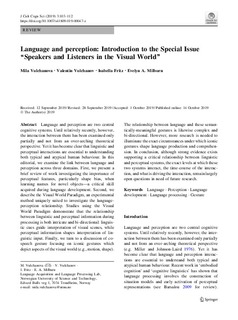| dc.contributor.author | Vulchanova, Mila Dimitrova | |
| dc.contributor.author | Vulchanov, Valentin | |
| dc.contributor.author | Fritz, Isabella | |
| dc.contributor.author | Milburn, Evelyn Arko | |
| dc.date.accessioned | 2020-02-26T09:26:59Z | |
| dc.date.available | 2020-02-26T09:26:59Z | |
| dc.date.created | 2019-10-15T12:07:24Z | |
| dc.date.issued | 2019 | |
| dc.identifier.citation | Journal of Cultural Cognitive Science. 2019, 3 (2), 103-112. | nb_NO |
| dc.identifier.issn | 2520-100X | |
| dc.identifier.uri | http://hdl.handle.net/11250/2643797 | |
| dc.description.abstract | Language and perception are two central cognitive systems. Until relatively recently, however, the interaction between them has been examined only partially and not from an over-arching theoretical perspective. Yet it has become clear that linguistic and perceptual interactions are essential to understanding both typical and atypical human behaviour. In this editorial, we examine the link between language and perception across three domains. First, we present a brief review of work investigating the importance of perceptual features, particularly shape bias, when learning names for novel objects—a critical skill acquired during language development. Second, we describe the Visual World Paradigm, an experimental method uniquely suited to investigate the language-perception relationship. Studies using the Visual World Paradigm demonstrate that the relationship between linguistic and perceptual information during processing is both intricate and bi-directional: linguistic cues guide interpretation of visual scenes, while perceptual information shapes interpretation of linguistic input. Finally, we turn to a discussion of co-speech gesture focusing on iconic gestures which depict aspects of the visual world (e.g., motion, shape). The relationship between language and these semantically-meaningful gestures is likewise complex and bi-directional. However, more research is needed to illuminate the exact circumstances under which iconic gestures shape language production and comprehension. In conclusion, although strong evidence exists supporting a critical relationship between linguistic and perceptual systems, the exact levels at which these two systems interact, the time-course of the interaction, and what is driving the interaction, remain largely open questions in need of future research. | nb_NO |
| dc.language.iso | eng | nb_NO |
| dc.publisher | Springer | nb_NO |
| dc.rights | Navngivelse 4.0 Internasjonal | * |
| dc.rights.uri | http://creativecommons.org/licenses/by/4.0/deed.no | * |
| dc.title | Language and perception: Introduction to the special issue "Speakers and listeners in the visual world" | nb_NO |
| dc.type | Journal article | nb_NO |
| dc.type | Peer reviewed | nb_NO |
| dc.description.version | publishedVersion | nb_NO |
| dc.source.pagenumber | 103-112 | nb_NO |
| dc.source.volume | 3 | nb_NO |
| dc.source.journal | Journal of Cultural Cognitive Science | nb_NO |
| dc.source.issue | 2 | nb_NO |
| dc.identifier.doi | https://doi.org/10.1007/s41809-019-00047-z | |
| dc.identifier.cristin | 1737165 | |
| dc.description.localcode | This article is distributed under the terms of the Creative Commons Attribution 4.0 International License (http:// creativecommons.org/licenses/by/4.0/) | nb_NO |
| cristin.unitcode | 194,62,60,0 | |
| cristin.unitname | Institutt for språk og litteratur | |
| cristin.ispublished | true | |
| cristin.fulltext | postprint | |
| cristin.qualitycode | 1 | |

